If you own a KitchenAid Mixer and want to venture into the world of homemade pasta making you will love my KitchenAid Pasta Recipe. Homemade pasta takes a little over an hour to make about a pound and a half of delicious fresh noodles.

Have you ever made fresh homemade pasta? Making spaghetti or even fettuccine at home is actually really easy. It takes a little time and patience, and within about an hours time you’ll have a batch of fresh pasta that will knock your socks off. My KitchenAid Pasta Recipe will make even the most novice cook a pasta making pro in no time.
Of course, the real star of this recipe is the KitchenAid Stand Mixer and pasta attachments to thank! They have the most amazing pasta attachments. I will be honest… if it wasn’t for their pasta attachments I would probably not be making pasta. The attachments are simple to use and easy to clean.
If you just received a KitchenAid Pasta Attachment or simply want to flex and learn some new culinary skills, pasta making is for you. Just like any new hobby or skill you learn—the more you make this recipe the better you will get at making homemade pasta. I find that I typically make homemade pasta for special occasions and Sunday dinners. I love to toss the pasta in my bolognese sauce, amatriciana sauce or even Alfredo sauce.
Jump to:
- Ingredients
- Directions
- Making the Pasta Dough
- Fresh Pasta Sheets
- Homemade Lasagna Noodles
- How to Make Spaghetti
- How to Cook Fresh Pasta
- Recipe FAQs
- How to Dry Fresh Pasta
- How to Store Dried Pasta
- How to Refrigerate Fresh Pasta
- How to Freeze Fresh Pasta
- Recipe Tips and Tricks
- Easy Pasta Recipes
- KitchenAid Pasta Recipe
Ingredients
Flour – I use All-Purpose flour to make my homemade pasta. Some people prefer to use 00 flour which can be difficult to get your hands on at a traditional grocery store. I have never tested this recipe with 00 flour—only with All-Purpose. Make sure you sift the flour prior to measuring. Remember you will also need additional flour for rolling out the dough, flouring the KitchenAid attachments, and flouring at the end after you cut the spaghetti or linguine.
Eggs – This is an egg based pasta. I prefer to let my eggs sit out for 30 minutes to start to get to room temperature, but its not necessary.
Salt – A little bit of salt is going to cut the flour taste.
Water – You only need a little bit of room temperature water. I like to work in 1-2 tablespoon servings as I mix the dough.
Directions
Making the Pasta Dough

In the stand mixer bowl, place the eggs, flour, salt and 2 tablespoons of water. Using the flat beater, attach it to the bowl and mix the ingredients on speed 2 for 30 seconds.
Remove the flat beater and replace it with the dough hook. Turn the dough on to speed 2 and let it knead for 2 minutes. At this time if the mixture looks to dry add 1 tablespoon of water at a time. It should form a ball and have no additional flour or ingredients in the bowl. The dough ball wills tart to make a smacking noise as it mixes.
Remove the dough from the bowl, flour a clean surface, and kneed with your hands for 1-2 minutes.
DO NOT SKIP THIS STEP. It is extremely important for rolling out the dough. By kneading the pasta dough by hand it will help work the gluten.
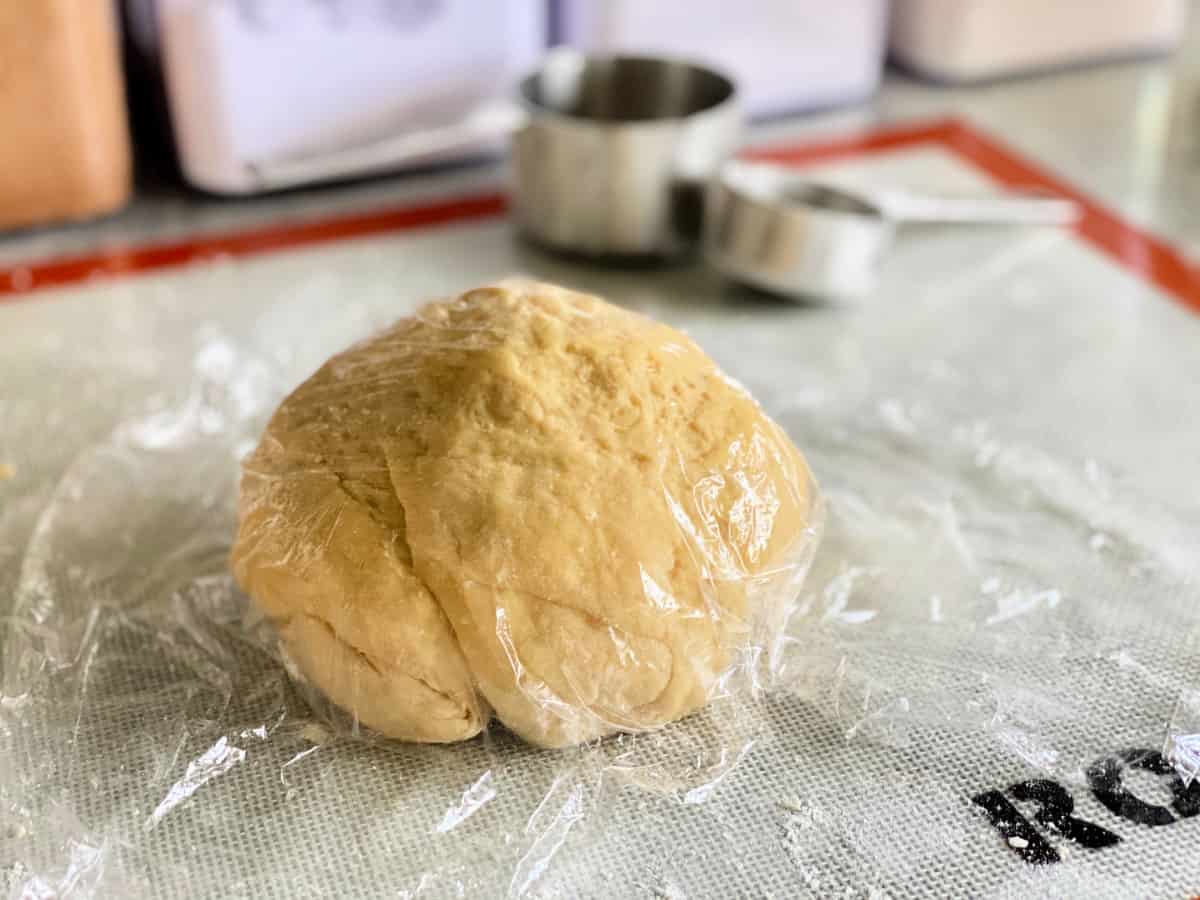
Form the dough into a disc/ball, place plastic wrap over the top of the dough, and let it rest for 20 minutes.
Fresh Pasta Sheets

Divide the dough into 4 pieces. Make sure you keep the dough you aren’t working with covered with a damp paper towel, kitchen cloth or plastic wrap. I like to use the same plastic wrap that the ball was covered in.
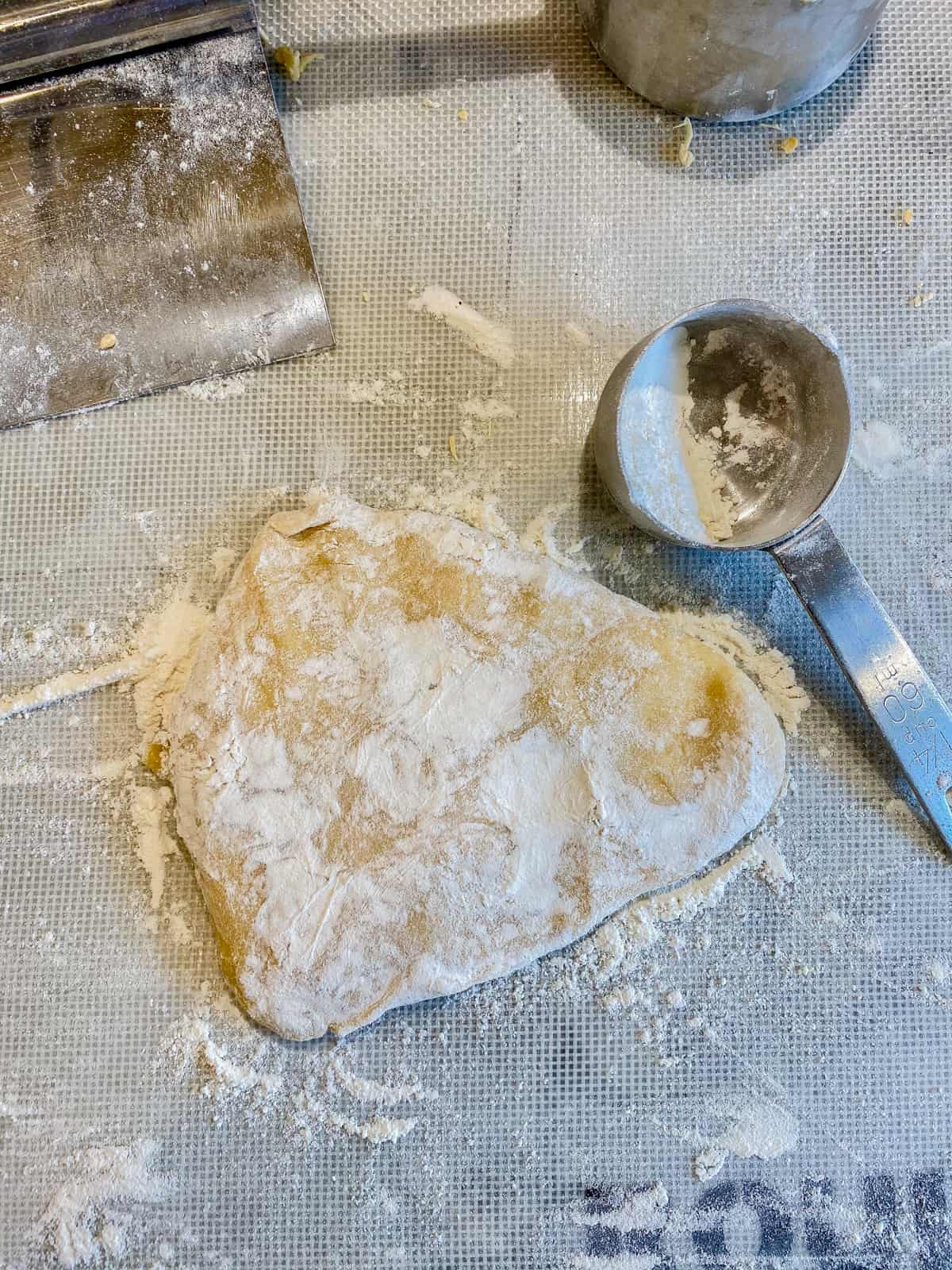
Attach the Pasta Sheet Roller attachment to the stand mixer. Take 1 of the 4 pieces of dough and flatten it until its about a half-inch thick.

Set the Pasta Sheet Roller to setting 1 and your stand mixer to Speed 2/4 and begin to carefully feed the dough through the attachment.

Once this is done you’ll want to fold the dough in half and then half again. Make sure it fits in the top of the attachment. Then run it through the Pasta Sheet Roller again.

Next, move your Pasta Sheet Roller to setting 2 and then carefully run the dough through. Repeat, by moving the setting all the way up to 5 until you have a thin sheet of pasta.
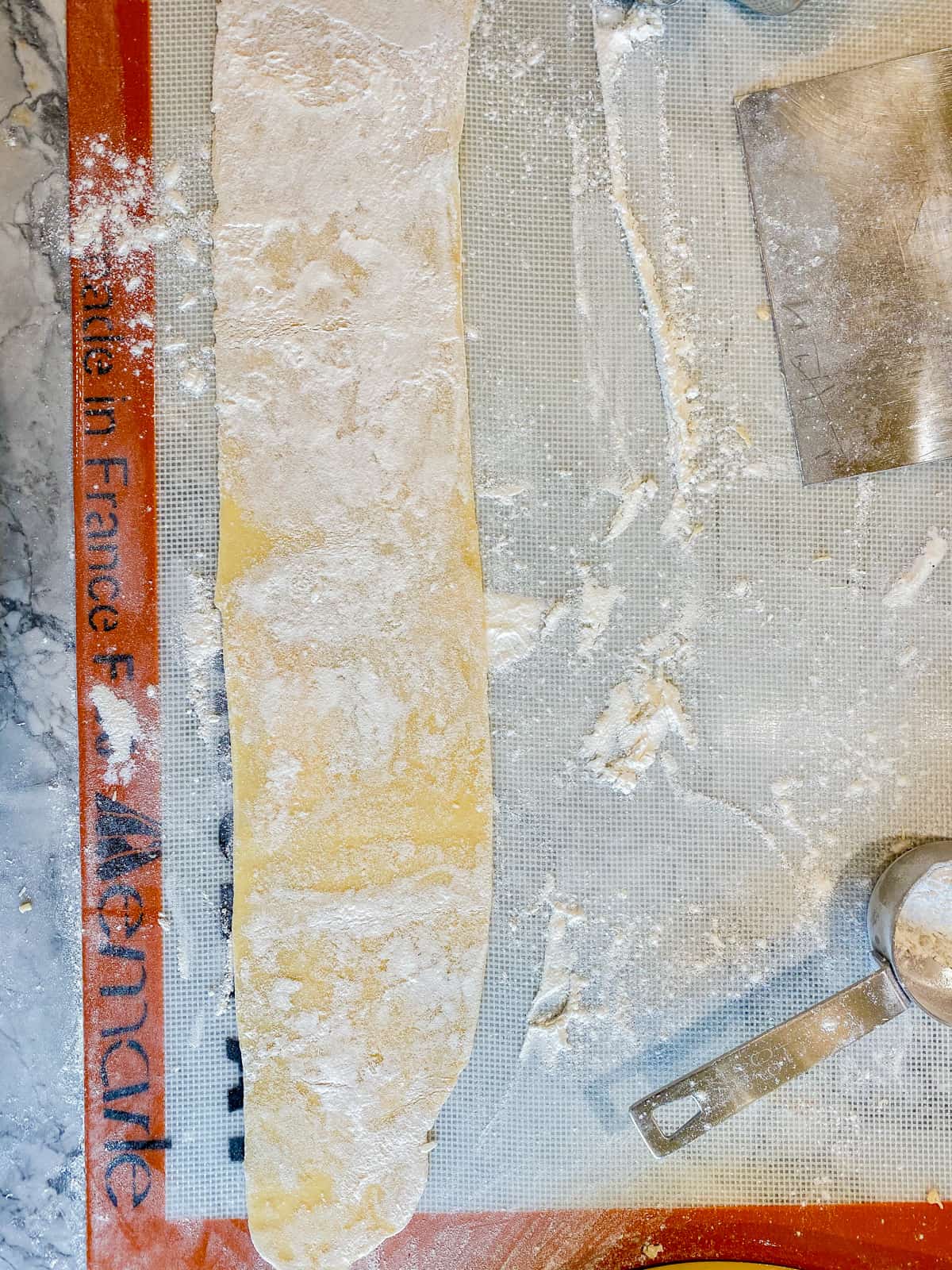
Pro Tip for easier handling – I typically cut the pasta sheet in half or in thirds by setting 2 or 3– it is much easier to work with. If not you will have very long pasta!
Homemade Lasagna Noodles

To make homemade lasagna noodles you will follow the process above but stop at the number 4 setting when you roll out the pasta sheets.
Then you will cut into 6-8 inch pieces and boil for 3 minutes until al dente. Drain in a colander, rinse with cool water, and then layer among parchment paper until you are ready to assemble the lasagna. These homemade pasta sheets also work great for lasagna roll ups. You just have to cut them into narrower sheets. The cooking time will be the same as traditional cooked lasagna noodles.
How to Make Spaghetti


Once you have 2 to 3 thin sheets of pasta, remove the Pasta Sheet Roller and add the Spaghetti attachment (or fettuccine attachment) to the stand mixer. Place the mixer on Speed 2 and carefully begin to feed the sheet of pasta through the attachment.

Once you have spaghetti/fettucine cut, dust with additional flour and lay it flat on a floured counter or on a drying rack for 10 minutes before cooking.
How to Cook Fresh Pasta

Bring a large stock pot to a rolling boil. Add at least 1 tablespoon of salt then cook fresh pasta for 3-4 minutes until desired consistency is achieved. Drain and quickly rinse with cool water to stop the cooking process and pasta from sticking together. Toss in your favorite sauce and enjoy!
Recipe FAQs
This is all going to depend on what type of pasta you are making. For egg noodles you will want to be on the pasta rolling setting of “4”. For lasagna noodles, fettuccine, spaghetti, and ravioli you can roll out the dough to pasta setting “4 or 5”. For tortellini, thin fettuccine, and thin linguine you can roll the pasta dough to settings “6 or 7”.
Yes, you can use All Purpose flour for pasta. It’s what I have used for years when making pasta.
Yes, it is totally worth the time and energy to make pasta from scratch. My family begs for me to make homemade fresh pasta for dinner all the time. It’s become a treat in my home.
Yes, you can add 1-2 teaspoons of garlic powder to the dough to give a slight garlic flavor. You can also add in dried herbs like parsley or even rosemary to the flour mixture before it is mixed.
This is a very common problem that most people face when making homemade pasta. Myself included. You will want to add additional flour on to the dough if it’s feeling on the sticky/moist side. Then knead the dough a little bit and let it rest for 5-10 minutes longer. I have found that by adding more flour to help dry it out a little and kneading it again and letting it rest is the ticket. I will cover the “faulty” piece and start with a new piece of dough while the other rests.
Yes, you need to let it rest for at least 5-10 minutes. I like to dust the fresh pasta dough with flour before I place it to dry. Then you can cook it.
Fresh homemade pasta cooks in minutes. Drop the fresh pasta dough into a pot of hot water that has a rolling boil to it. Make sure you salt the water very well and then cook for 3-4 minutes until al dente or at your preferred consistency.
Yes, you absolutely can and this is a great way to store leftovers for an easy lunch or dinner for a future buy day. If the pasta has been tossed in sauce, even better. You will want to portion the cooked pasta in sauce into individual portions in a freezer safe container. Freeze up to 3 months. Then thaw in the refrigerator before reheating.
How to Dry Fresh Pasta
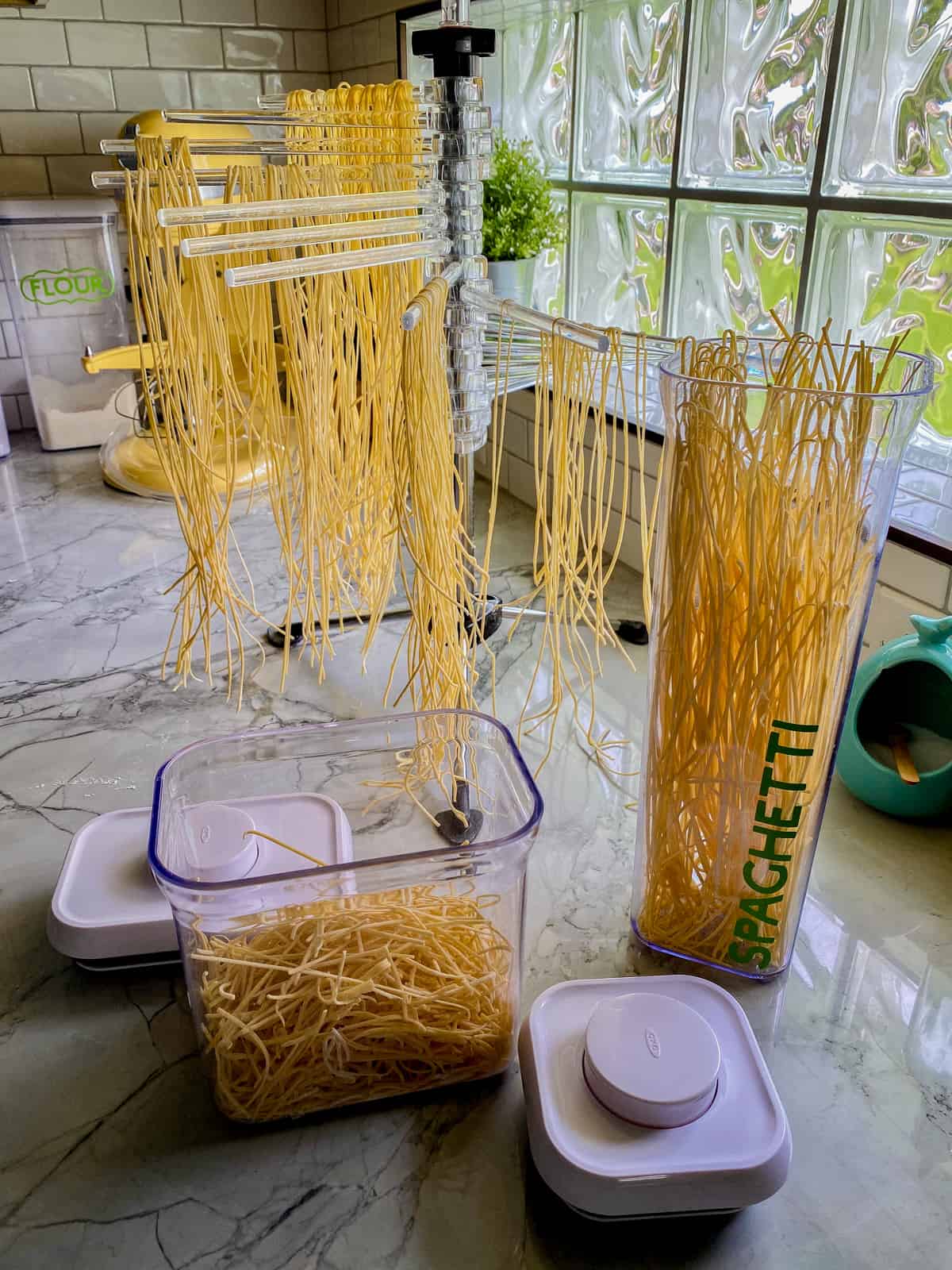
If you decide you are going to dry out the pasta instead of cooking it right away make sure you toss the fresh pasta with flour prior to drying. Dry on a drying rack for at least 24 hours. Depending on the humidity will depend if it takes the full 24 hours. I live in Florida—it takes at least 24 hours for me to dry pasta.
How to Store Dried Pasta
Once the pasta is dry you can store the dried pasta in a sealed container in a dry dark place for up to a month.
How to Refrigerate Fresh Pasta
Refrigerating Pasta – If you prefer to refrigerate your pasta, you need to make sure that it only stays refrigerated for one day. This will ensure that bacteria growth does not happen to the pasta. Before you refrigerate, you will dry out the noodles on a hanging rack for 10 minutes. Then, toss in additional flour and carefully nest the pasta. Grab a small bunch of fresh pasta, make a swirling motion and gently lay on a parchment lined baking sheet. Repeat until all your pasta is in nest. Place plastic wrap over the baking sheet and store in the refrigerator for up to 1 day until you are ready to cook. * You can also refrigerate the pasta by folding pasta in half and not in nest.
How to Freeze Fresh Pasta
Freezing Pasta – Dry out the noodles on a hanging rack for 20 minutes. Then, toss in additional flour and carefully nest the pasta or scatter the fresh pasta on a parchment lined baking sheet. Repeat until all your pasta is in nested or laying out on a baking sheet. Let the fresh pasta rest for an additional hour then transfer to a freezer bag. Make sure to lay the pasta in single piles (if nested) on a flat surface for maximum space saving. Once you are ready to cook simply place the frozen pasta noodles into boiling water. *Frozen pasta will be good for up to 8 months if store properly!
Recipe Tips and Tricks

Here are a few of my favorite tips and tricks when making homemade pasta.
- Recipe Yield – This recipe yields about 1-¼ – 1-½ pounds of pasta. Typically enough to feed 8 people.
- Holes forming in Dough – If you are starting at the rolling flat step and you find your dough is not stretching and instead forming holes this means either you have not worked the dough enough by hand or it is too dry. Try working the dough again for another 2-3 minutes and letting it rest for at least 5-10 before you begin to try to run the dough into the flat roller attachment.
- Rolling Pasta – While rolling out pasta I typically cut the pasta sheet in half once the flatten sheets go through setting 2 or 3– it is much easier to work with.
- Nesting Pasta – To nest the pasta, toss the fresh pasta in additional flour, let dry at least 20 minutes then spin small amounts of pasta into a nest and let continue to dry.
- Pasta Water – Save about a half cup of the pasta water to add into sauces that you toss the pasta with. The starch from the water will help thicken the sauce and allow for the sauce to stick to the pasta better.
- Read the Recipe – Yes, read the recipe below then read it again prior to making the pasta. There are a lot of steps to the process, but I promise it will be well worth it! Make yourself familiar with the recipe so you can execute with ease.
Easy Pasta Recipes
Looking to use your homemade pasta? I have dozens of pasta recipes you can make to enjoy your fresh pasta.
If you make this KitchenAid Pasta recipe, I would be honored and love for you to take the time to leave a ⭐ star rating and comment! I spend hours developing and testing these recipes, and always love to hear feedback and user experience!
Don’t forget to FOLLOW ME on Facebook, Pinterest, and Instagram, and subscribe to my email list!

KitchenAid Pasta Recipe
Equipment
- KitchenAid Pasta Attachment
- Pasta Drying Rack
Ingredients
- 4 large eggs
- 3-½ cups all-purpose flour sifted
- ½ teaspoon salt
- ¼ cup water *start with 2 tablespoons
Instructions
Making the Spaghetti Dough:
- In the stand mixer bowl, place the eggs, flour, salt and 2 tablespoons of water. Using the flat beater, attach it to the bowl and mix the ingredients on speed 2 for 30 seconds.4 large eggs, 3-½ cups all-purpose flour, ½ teaspoon salt, ¼ cup water
- Remove the flat beater and replace it with the dough hook. Turn the dough on to speed 2 and let it knead for 2 minutes. At this time if the mixture looks too dry add 1 tablespoon of water at a time.
- Remove the dough from the bowl and kneed with your hands for 1-2 minutes. (Do not skip this step–it's extremely important for rolling out the dough. By kneeding by hand it will help work the gluten.) Form the dough into a disc/ball, place plastic wrap over the top of the dough, and let it rest for at least 25 minutes.
Rolling the Spaghetti:
- Divide the dough into 4 pieces (keeping the dough you aren't working with it covered with a damp paper towel/kitchen cloth/plastic wrap).
- Attach the Pasta Sheet Roller attachment to you stand mixer. Take 1 of the 4 pieces of dough and flatten it until its about a half-inch thick. Set the Pasta Sheet Roller to setting 1 and your stand mixer to Speed 2/4 and begin to carefully feed the dough through the attachment.
- Once this is done you'll want to fold the dough in half and then half again. Make sure it fits in the top of the attachment. Then run it through the Pasta Sheet Roller again.
- Next, move your Pasta Sheet Roller to setting 2 and then carefully run the dough through. Repeat, by moving the setting all the way up to 5 until you have a thin sheet of pasta. *I typically cut the pasta sheet in half or in thirds by setting 2 or 3– it is much easier to work with. If not you will have some crazy long pasta!
- Once you have 2-3 thin sheets of pasta, remove the Pasta Sheet Roller and add the Spaghetti attachment to the stand mixer. Place the mixer on Speed 2 and carefully begin to feed the sheet of pasta through the attachment.
- Once you have the spaghetti cut, toss in additional flour and lay flat on a floured counter or on a drying rack for 10 minutes before cooking.
Cook the Spaghetti:
- Cook the spaghetti in a pot of boiling water with 1 tablespoon of salt for 3-4 minutes or until al dente. Drain and rinse with cool water before tossing in your favorite sauce.
Video
Notes
- Recipe Yield – This recipe yields about 1-¼ – 1-½ pounds of pasta. Typically enough to feed 8 people.
- Holes forming in Dough – If you are starting at the rolling flat step and you find your dough is not stretching and instead forming holes this means either you have not worked the dough enough by hand or it is too dry. Try working the dough again for another 2-3 minutes and letting it rest for at least 5-10 before you begin to try to run the dough into the flat roller attachment.
- Rolling Pasta – While rolling out pasta I typically cut the pasta sheet in half once the flatten sheets go through setting 2 or 3– it is much easier to work with.
- For drying pasta: Let the cut pasta hang or lay flat and dry in individual strands for 24 hours until the pasta is dried. If drying on a rack the pasta will begin to fall off as it completely dries.
- Nesting Pasta – To nest the pasta, toss the fresh pasta in additional flour, let dry at least 20 minutes then spin small amounts of pasta into a nest and let continue to dry.
- Pasta Water – Save about a half cup of the pasta water to add into sauces that you toss the pasta with. The starch from the water will help thicken the sauce and allow for the sauce to stick to the pasta better.
- Store – Store dried pasta in a well sealed bag or container. It will last for up to 1 month in an airtight container store in a cool dark place.
- Read the Recipe – Yes, read the recipe below then read it again prior to making the pasta. There are a lot of steps to the process, but I promise it will be well worth it!






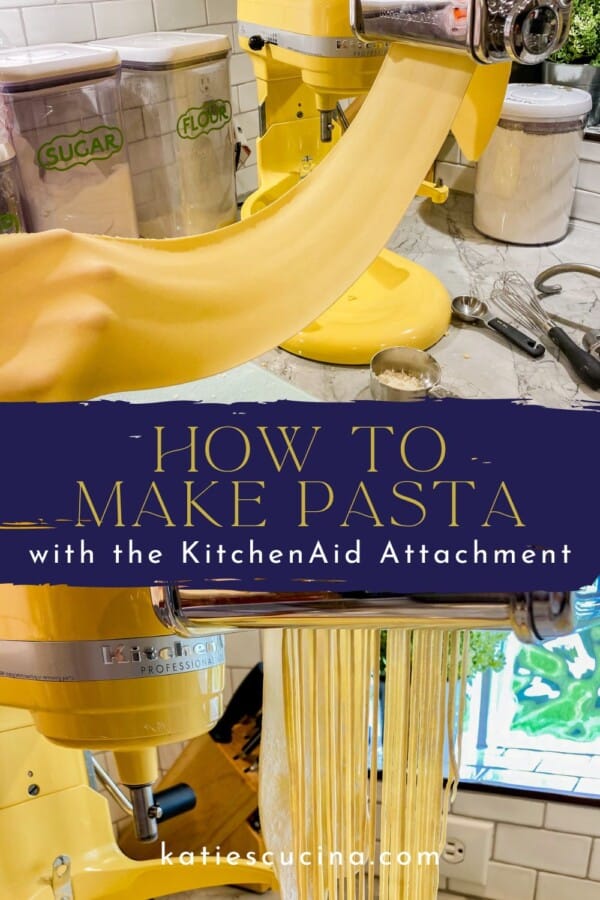


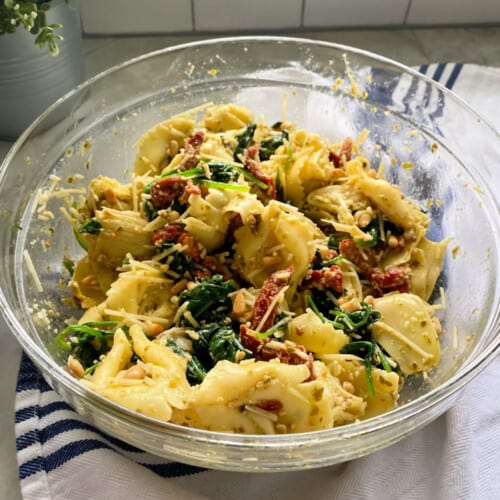






Nicole Spooner
Hi do you know how many people this recipe would feed? I have 4 adults and 3 very hungry pasta eating kids and thought to maybe 1 and a half this but not sure what that does to the measurements.
Katie
Hi Nicole, I’ve been refining my pasta making this year since publishing this post and video years ago! I’ve found for my family of 4 (2 adults and 2 kids) we can eat off of 1/4 of the dough. I dry the rest for other meals. That gives us no leftovers. I would venture to say that if you make this recipe you should be able to feed your whole group plus a little leftover for the next day! Hope that helps!
Joe
Hello Katie,
Do you measured 3 1/2 cup of flour then sifted, or do you measured a sifted 3 1/2 cup of flour? Just want to be clear. Thank you!
Katie
Hi Joe, I always measure sifted flour. So sift flour, then measure 3-1/2 cups! 😉 Hope that helps!
Keith
I was hesitant at first, but then I just jumped in, followed directions (or tried to), and they turned out amazing. Thank you so much!
Katie
Great job Keith!!! Glad your pasta turned out well.
Lucille A. Hoerle
I loved your blog so much I immediately went to the Kitchen Aid website to order a set. I have the old manual crank type pasta machine and use it often, but as you must know it is difficult at best. Unfortunately, after I put the attachments into my cart and proceeded to check out, the price was not the sale price with over $100 more. I have to wait to discuss this with them after 8 a.m. but not leaving a very good taste in my mouth!
Katie
Hi Lucille, thank you for taking the time to leave a comment. I’m glad you enjoy my blog. I’m sorry to hear about the price discrepancy. Hopefully, KitchenAid was able to assist you.
Andrea
Tried this recipe and it was delicious!!
Katie
Thanks Andrea! Glad you enjoyed the pasta!
Donna Huff
Katie
Just got my kitchen aid mixer for Christmas. I gave my husband my wishlist. I got the pasta attachments by accident. As soon as I knew I was getting them I started watching your video. Today (Dec 2018) I watched you again and I MADE PASTA! Thank you so much. As soon as I made it I cooked it as you instructed. Thank you so much. The pasta was awesome.
Katie
Donna, I’m so happy to hear this! Have so much fun making food with your mixer and delicious pasta! You should try this recipe for Lemon Bruschetta Pasta with Grilled Chicken. Compliments the fresh pasta perfectly.
Ticia Messing
THANK YOU! Your recipe explains why my attempt following the recipe from the kitchenaid booklet didn’t work. They don’t have you add anywhere near enough water. I’m going to try your version Later on.
Katie
Hi Ticia, so glad I could help answer the missing answer to your question. Have fun making pasta!
Mark
I was looking to find out how to make homemade Spaghetti because I just received my first ever KitchenAid mixer today and I saw your channel on youtube and you made this look so easy to make now I just have to try it I have never made much of anything homemade so I am working up to making more things homemade So thank you for posting your videos on youtube
Katie
Thanks Mark! Honestly–if you have the time you can make it! Making pasta is really easy and I sadly haven’t made fresh pasta in forever. Your inspiring me to roll up my sleeves and make fresh pasta again soon!
Jackie
I made the spaghetti noodles for the first and did everything the recipe called for. When finished, I nested them as you advised. I didn’t start my water for the noodles until then so the spaghetti noodles sat nested for about 30 min. When I dropped the nest into water, the noodles did not separate. Instead they just became a glumpy mess. Then I tried to un-nest the remaining noodles prior to placing them in the water. What a mess. The taste was good but I’m certain that I did something wrong. Your advise please
Katie
Hi Jackie–so sorry that your pasta didn’t turn out right. Next time you go to make the pasta have your water ready and cook them immediately. I’ve never waited to cook my pasta. So if you are going to wait to cook the pasta maybe I wouldn’t nest them… just lay them flat. Hope that helps!
Chris
yes I was asking about how and when to freeze the pasta
Chris
Hi, great tutorial. The tip for using more water was the best. I want to know when’s the best time to freeze the pasta. I want to make it for my granddaughters that live 4 hours away. I am not sure if I refrigerate and keep cold until I get there then make the pasta or make the pasta roll it out with attachments and refrigerate.
Katie
Hi Chris, I would cook the pasta, refrigerate (put on ice during your drive) and then reheat while at your grand daughters house. I have not had any luck freezing the raw dough to date. Hope that helps. Happy Cooking!
Cassie | Bake Your Day
Homemade pasta just can’t be beat. This is great, Katie!
Katie
Thanks Cassie!
Nutmeg Nanny
Great tutorial 🙂 homemade pasta is the best!
Ashley Bee (Quarter Life Crisis Cuisine)
I’ve made ravioli a few times and it’s just incredible. I love making a whole meal from scratch!
Katie
Ashley–ravioli’s are my next big thing to tackle!
gloria
Did you try the ravioli yet, and if so, did you make a video for it?
Katie
Hi Gloria! I have not tried the ravioli attachment yet. When I do I will make a video for sure! 🙂
Lesley
It looks great. If your not cooking straight away won,t the spaghetti stick together? KR lesley
Katie
Hi Lesley, thanks for stopping by and reading Katie’s Cucina. I did dry my pasta nest out and then freeze them. I’m still newish to pasta making. I found that when I defrosted my noodles I didn’t have any sticking together. When I through them from the freezer into the boiling water they all stuck together. Hope this helps!
Angie @ Big Bear's Wife
I really need to get that attachment! I love it! Loved the video too, you make it look so easy! I’ve always wanted to make homemade pasta!
Katie
Thanks Angie! It is! After getting the hang of making homemade pasta it’s so easy
Mai
Hi! Thank you so much for the great guide & video on making pasta with your Kitchen Aid mixer! I’m very excited to try it. Just curious, though – can you freeze the pasta once it is made (prior to cooking)? If so, how would you recommend storing it (what type of packaging and for how long can it be kept)? Thanks!
Katie
Hi Mai, thanks for stopping by Katie’s Cucina. I did freeze a few batches. Per KitchenAid booklet that comes with the pasta attachments they recommend drying out the pasta for one hour. Then wrapping in nest and placing in a freezer bag. I found that when I defrosted the pasta and then cooked it–it turned out fine. When I placed the frozen pasta in the hot boiling water it all cooked together. I like to keep food in my freezer for no longer than 3 months. My pasta made it two weeks in the freezer before I couldn’t resist to cook it! Good luck!
addie | culicurious
I love making homemade pasta. It’s very rewarding and much more tasty! 🙂
Katie
Thanks Addie–yah I can see myself making homemade pasta for “special” meals!
Terri C
Very nice post, looks wonderful. You should be proud bread pasta and sauce in one meal! Not everyone gets to eat like that at home 🙂
Katie
Thanks Terri–I’m super proud of my recent accomplishments!
danielle
I NEED that attachment!